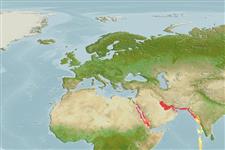Malacostraca |
Isopoda |
Sphaeromatidae
Environment: milieu / climate zone / depth range / distribution range
Ecology
Benthic. Tropical
Western Indian Ocean: Iran and Saudi Arabia.
Length at first maturity / Size / Weight / Age
Maturity: Lm ? range ? - ? cm
Members of this genus are predominantly found on the continental shelf. Usually found from the intertidal to subtidal zones, in algal and seagrass beds, in dead intertidal and subtidal corals, dead barnacles and oyster shells (Ref. 107636). Members of the family Sphaeromatidae are omnivores in general (Ref. 108484). Genus Cymodoce are considered herbivores and predators of sponges (Ref. 108483).
Life cycle and mating behavior
Maturity | Reproduction | Spawning | Eggs | Fecundity | Larvae
Members of the order Isopoda are mostly gonochoric. Mating behavior: Mating usually occurs before and sometimes during the parturial molt. Sperm transfer is indirect. Life cycle: Eggs are brooded in the marsupium, which later hatch into manca postlarva before developing into adults.
Schotte, M. and B. Kensley 2005 New species and records of Flabellifera from the Indian Ocean (Crustacea: Pericarida: Isopoda). Journal of Natural History 39(16):1211-1282. (Ref. 3781)
IUCN Red List Status
(Ref. 130435: Version 2025-1)
CITES status (Ref. 108899)
Not Evaluated
Not Evaluated
Threat to humans
Harmless
Human uses
| FishSource |
Tools
More information
Trophic EcologyFood items (preys)
Diet composition
Food consumption
Predators
Population dynamicsGrowth
Max. ages / sizes
Length-weight rel.
Length-length rel.
Length-frequencies
Mass conversion
Abundance
Life cycleReproductionMaturityFecunditySpawningEggsEgg developmentLarvae PhysiologyOxygen consumption
Human RelatedStamps, coins, misc.
Internet sources
Estimates based on models
Preferred temperature
(Ref.
115969): 20.7 - 26.2, mean 22.5 (based on 34 cells).
